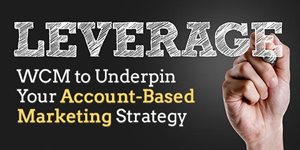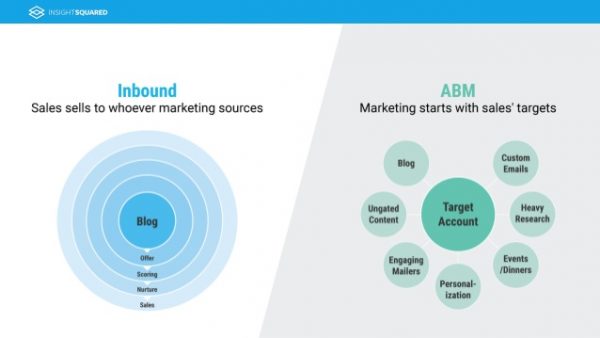How to Utilize WCM to Support Your Account-Based Marketing
As we all know content without access is worthless, however, 65% of content is unused mostly  because the content is not findable or relevant. As a matter of fact, some studies even claim that salespeople end up spending 30% of their time creating content themselves because they simply can’t find the right content even if it exists somewhere in the portal. In many cases, what it takes for a salesperson is just having access to the right content from a single browser-based access point. The need for aligning sales and marketing around the massive wave of data, now, has been driving a tremendous amount of interest in adopting an account-based marketing (ABM) strategy.
because the content is not findable or relevant. As a matter of fact, some studies even claim that salespeople end up spending 30% of their time creating content themselves because they simply can’t find the right content even if it exists somewhere in the portal. In many cases, what it takes for a salesperson is just having access to the right content from a single browser-based access point. The need for aligning sales and marketing around the massive wave of data, now, has been driving a tremendous amount of interest in adopting an account-based marketing (ABM) strategy.
For those who are not acquainted with the term, an account-based marketing (ABM) approach is a strategic go-to-market approach and creates more specific, relevant, and personalized interactions to drive engagement and conversion at a targeted set of accounts or expand existing ones. To put this into perspective, Jon Miller from Engagio likens ABM to fishing with spears compared to a traditional demand gen approach of ‘fishing with nets.' In other words, an ROI is not “somewhere over the rainbow” when adopting an ABM approach as it is proactive, rather than reactive.
According to the industry veterans, the rise of ABM doesn’t show any sign of slowing down.
“As of March 2017, the number of ABM-related inquiries we’ve received has already exceeded the total number of inquiries for 2016. ABM is getting all this attention because of the strong return on investment,” said Todd Berkowitz, a Gartner Research Vice President who focuses on B2B technology marketing and sales, and Julian Poulter, a Gartner Research Director for CRM Sales and Marketing. “ABM has the potential to be one of the most transformative go-to-market strategies that a technology service provider will undertake.”
“To break down walls between sales and marketing, ABM is pretty close to a silver bullet in that it aligns programs’ dollars and focus on the accounts that the sales teams care about. So there's inherent buy-in. That said, ABM is only as good as your visibility into your highest potential accounts and best-fit customer segments, which gets clearer over time. So it’s most effective when deployed as part of a comprehensive set of targeting strategies,” said Dave Karel, Head of B2B Marketing, LinkedIn Marketing Solutions.
According to B2B research and advisory firm, SiriusDecisions, ABM adoption doubled in 2016 over 2015 and is slated to grow even more in 2017. Forrester Research also acknowledges how marketing and sales alignment could benefit businesses by concluding: “Aligned organizations achieve an average of 32% annual revenue growth while less aligned companies report an average 7% decline in revenue.”
Now that I have made my case about the importance of having an ABM strategy and technology in place, let’s delve into its benefits to organizations. Before doing so, it is worth noting that your ABM efforts are only as good as your data quality. As indicated in a CMS-Connected article earlier, “in 2018 and beyond, employing data-savvy marketers will be the vantage point that will make or break it for companies.” Instead of relying on “gut feelings,” the marketing and sales organizations will be data-driven and laser focused.
Unlike a traditional way of executing segmented marketing which has largely been based on demographic assumptions about customer types, ABM is based on data tracking the intent of specific companies and/or individuals. It alerts sales and marketing teams with relevant and actionable insights compiled based on that data.
According to Kimble Applications, the average sales cycle length for professional services firms has elongated from 88 days to 92 days in 2017. A laser-focused approach makes ABM more relevant to the target prospect. As a result, the more laser focused the customer touchpoints get, the shorter the sales cycle becomes.
An ABM approach is not the same as inbound marketing which is driven by content marketing. Joe Chernov, vice president of marketing at InsightSquared, says: “Content marketing leaves off at a certain point, but business goals go a little beyond that.” He believes that account-based marketing plugs that hole thus brands should use both approaches.

Artificial Intelligence Injected Into ABM
The integration of artificial intelligence and machine learning is one of the most critical developments in ABM technologies. San Francisco-based ABM solution provider, Demandbase, for instance, has recently launched its Conversion Solution that delivers account and buyer insights through Salesforce, Slack, and LinkedIn Sales Navigator. Due to its integration with the customer’s data in Salesforce CRM, the Conversion Solution doesn’t require a separate login for multi-channel insights delivery to monitor insights in real-time on the Salesforce Platform. To put this into perspective, if one of their accounts is visiting their website (or on some other channels), the sales team will be informed accordingly in real time.
Michael Kostow, SVP and GM of Salesforce Pardot, said, “As the #1 leader in CRM, Salesforce continues to lead the way in helping sales teams to be more productive and successful. Our AI-powered Einstein ABM solution enables marketing and sales teams to target their most valuable accounts, personalize campaigns and engage with prospects at scale. Demandbase’s Conversion Solution complements Einstein ABM by offering our mutual customers a unique set of account-based insights.”
Given the abundance of channels available to today’s consumers, it is nothing unexpected to see them bouncing back and forth between a mix of media prior to making a purchase. Marketers may not have control over which path consumers will choose anymore, they certainly have a technology to have a seamless narrative across all those channels and accurately measuring the performance of each.
How to Leverage WCM to Execute an ABM Strategy
Like every strategy, developing and executing the right ABM strategy may take some time and lots of experiments. During this experimental period, buying an ABM technology is not necessary as you can kick it off with leveraging your existing content management system as well. Once you have defined the right strategy, you will know what capabilities are the most important to have for your organizations.
Laser-targeted audience: If your organization has an industry or company-specific target, individuals can be identified by corporate IP addresses when they visit websites. When the information is linked to a content management system (CMS), IP lookup data can help you deliver personalized content on a landing page that increases the likelihood of engagement.
Omnichannel Experiences: Considering content is the heart and soul of every strategy, omnichannel marketing strategy has become one of the main focus areas for technology providers as well as content creators. With this in mind, omnichannel is another important tactic of an ABM strategy. Now that content can be separated from layout, the repurposing and reuse of content to multiple sites, devices, apps and distribution channels are easier with headless or decoupled CMSes. Today, many WCM platforms provide a stateless API that allows users to access and retrieve content and delivery of services through the cloud.
Personalization: Account-based marketing is for those who know who they want to target so they design specific personalized campaigns for each account. This increasing demand for personalized and contextualized experiences naturally sets a domino effect in motion for the rise of WCM vendors to adopt stronger, more tightly integrated personalization capabilities through either acquisitions or from building the capabilities in-house. Although account-based marketing is a B2B marketing strategy, and these brands are not in the B2B market, Amazon and Neftlix are great examples, at least to understand the role of behavioral targeting and personalized content in customer engagement as 35% of what consumers purchase on Amazon and 75% of what they watch on Netflix come from account-based recommendations based on their machine learning algorithms.
Search: On top of the explosive growth of unstructured content, with the rising magnitude of omnichannel, not only are companies dealing with the mass amount of data at their disposal; but also connecting with and analyzing unstructured content, e.g. email, chat, and document repositories.
On the other hand, the costs of searching for information to companies has been underestimated, yet it has a big impact. Search capabilities are pivotal for external and internal shareholders of any organization because today’s modern customers tend to be self-researchers and they search your website for information long before they create contact with sales or a support department. It means that one of your first consumer-facing touchpoints relies on your search capabilities. Therefore, today almost every major WCM vendor makes their search capabilities more intelligent to bring forward the most relevant information.
Predictive Analytics: One of the premises of artificial intelligence and machine learning algorithms is handling massive amounts of data while extracting value out of it. Therefore, more content management software providers are adding artificial intelligence and natural language technologies to their platforms through acquisitions in an effort to simplify unstructured content management and related processes. Here are some WCM capabilities that may help with an ABM strategy:
-
Predict a likelihood of conversion through a particular content before it is even published.
-
Understand which content topic is the most relevant for each customer across channels through the integration with customer relationship management systems and marketing automation systems.
-
Deliver user-specific content experiences via metadata that can help them retrieve every occurrence of a specific type of content, such as all product descriptions, positioning statements, value propositions, setup instructions, etc.
-
Eliminate biased decision making processes by taking the guesswork out of what content to produce and which platform to be on.
My POV
Account-based marketing is not the right approach for all B2B businesses. It, typically, is recommended for those which have accounts that have complicated B2B needs. It is very beneficial in the cases of when organizations know which accounts to target and are willing to design specific personalized marketing programs for each account. With an ABM strategy, big returns are built up by small steps taken patiently but it cultivates a longer and deeper customer relationship. When we think about the dynamics of the B2B market, it is not very uncommon for businesses to move forward slower than their B2C counterparts anyway.

Venus Tamturk
Venus is the Media Reporter for CMS-Connected, with one of her tasks to write thorough articles by creating the most up-to-date and engaging content using B2B digital marketing. She enjoys increasing brand equity and conversion through the strategic use of social media channels and integrated media marketing plans.